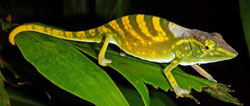A new chameleon species from Madagascar on the brink of extinction – “A tarzan yell for conservation”

Male holotype of Calumma tarzan, stress colouration fully developed. Copyright Frank Glaw<br>
The species was discovered in a small rainforest fragment very close to the village formerly known as Tarzanville. “Therefore, we dedicated the new species to the fictional forest man “Tarzan” in the hope that this famous name will promote awareness and conservation activities for this apparently highly threatened new species and its habitats, Madagascar's mid-altitude rainforest”, says PhD student Philip – Sebastian Gehring, first author of the description of this new species.
The Tarzan – chameleon should be considered as “Critically Endangered” because its recent distribution area covers probably less than 10 km2, there is continuing decline in the extent and quality of much of its habitat, and none of the habitats are included in the network of protected areas yet. The known habitats of this new chameleon should be protected as soon as possible in order to ensure the survival of this splendid species and other locally endemic endangered amphibian and reptile species occurring in these forest remnants, thereby using the Tarzan chameleon as a flagship species.
Source:
Gehring, P.-S., M. Pabijan,, F. Ratsoavina, J. Köhler, M. Vences & F. Glaw:
A Tarzan yell for conservation: a new chameleon, Calumma tarzan sp. n., proposed as flagship species for the creation of new nature reserves in Madagascar.- Salamandra 46(3) 151–163
Media Contact
All latest news from the category: Life Sciences and Chemistry
Articles and reports from the Life Sciences and chemistry area deal with applied and basic research into modern biology, chemistry and human medicine.
Valuable information can be found on a range of life sciences fields including bacteriology, biochemistry, bionics, bioinformatics, biophysics, biotechnology, genetics, geobotany, human biology, marine biology, microbiology, molecular biology, cellular biology, zoology, bioinorganic chemistry, microchemistry and environmental chemistry.
Newest articles

Sea slugs inspire highly stretchable biomedical sensor
USC Viterbi School of Engineering researcher Hangbo Zhao presents findings on highly stretchable and customizable microneedles for application in fields including neuroscience, tissue engineering, and wearable bioelectronics. The revolution in…

Twisting and binding matter waves with photons in a cavity
Precisely measuring the energy states of individual atoms has been a historical challenge for physicists due to atomic recoil. When an atom interacts with a photon, the atom “recoils” in…

Nanotubes, nanoparticles, and antibodies detect tiny amounts of fentanyl
New sensor is six orders of magnitude more sensitive than the next best thing. A research team at Pitt led by Alexander Star, a chemistry professor in the Kenneth P. Dietrich…





















